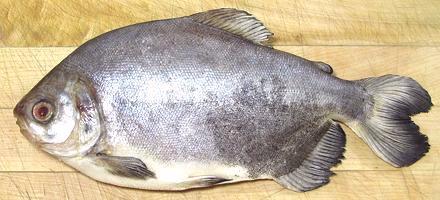 [family Characidae]
[family Characidae]
This family of fish are native to the rivers of South America and Africa. The South American ones have a very bad reputation for biting (and stripping cows to bare bones in a few minutes - not actually true), but several fish in the Pacu part of the family are farmed for sale in the markets, and they are really rather good eating. Pacus do bite, and one has a reputation for biting off the balls of skinny dippers, but they don't run in shoals like the famous Red-Bellied Piranha, which may also end up on the dinner plate. The African ones don't bite.
Piranha/Paku are related to Carp and Milkfish at the suborder level, and are also very fine eating - for anyone accustomed to eating fish who's flesh is infested with thread like spines - a skill very much worth developing, as some of the most delicious fish are this way.
More on Varieties of Fish (very
large page).
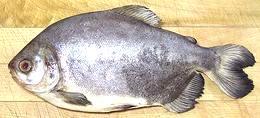 [Butterfish (Asian Market - wrong); Piaractus mesopotamicus
(fb Pacu) | similar Colossoma macropomum
(fb Cachama)]
[Butterfish (Asian Market - wrong); Piaractus mesopotamicus
(fb Pacu) | similar Colossoma macropomum
(fb Cachama)]
This is the Pacu with the reputation for biting the balls off skinny
dippers, mistaking them for some of the floating nuts it normally
feeds on. this fish can get to 21 inches and 44 pounds, and, whether
the stories are true or not, it has teeth to do that. The photo
specimen was found in the frozen fish cases of a large Asian market
here in Los Angeles, labeled "Butterfish", though it is entirely
unrelated to the Butterfish family or to any other fish so called.
Details and Cooking.
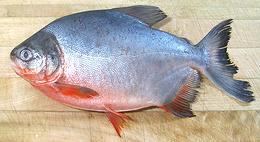 [Red Pompano (Asian Markets - wrong); Piaractus brachypomus alt.
Colossoma brachypomum]
[Red Pompano (Asian Markets - wrong); Piaractus brachypomus alt.
Colossoma brachypomum]
This fish is not as toothy as it's relative, the Caranha (see
above) which has the reputation as a ball biter, but enough that
Fishbase lists it as "Traumatigenic", able to inflict serious bites -
but it is not to be confused with the Red Bellied Piranha, which has
an underbite jaw and sharper teeth. This fish is found in Brazil and
Argentina, and farmed in South America and Asia. This fish can
grow to 35 inches and 55 pounds, but the photo specimen was 13 inches
long and weighed 1 pound 6-1/4 ounces. It was purchased off the ice
at a Philippine fish market in Los Angeles, in early 2014.
Details and Cooking.
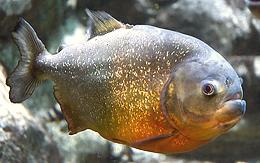 [(fb), Red Bellied Piranha; Pygocentrus nattereri]
[(fb), Red Bellied Piranha; Pygocentrus nattereri]
These fish do run in shoals, but defensively, not for hunting.
Generally they are minor predators and scavengers. They are not usually
aggressive, but during times of food shortage they have been known to
kill people, though usually they just bite off a few fingers and toes.
They are much more often eaten by people rather than eating people.
Stories of them stripping cows to bare bones in minutes have not stood
up to examination. This fish can grow to over 20 inches and 8-1/2
pounds. They are not considered endangered and are not currently
farmed. photo by Gregory Moine distributed under
license Creative Commons
Attribution 2.0 Generic.
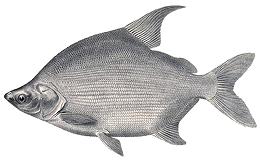 [Genera Citharinops, Cithardium, Citharinus]
[Genera Citharinops, Cithardium, Citharinus]
Lutefish can be found in all the major rivers of West, Central and
East Africa. They are filter feeders, and unlike the Piranhas, do
not bite. They are common enough to be significant food fish, but
not much detailed information is available. They all look pretty
much like the drawing, but the lower fins are often red.
These fish can grow to about 33 inches and 40 pounds. They are not
considered endangered and are not currently farmed.
Drawing from Fishes of the Nile, copyright
expired.